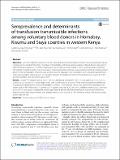Seroprevalence and determinants of transfusion transmissible infections among voluntary blood donors in Homabay, Kisumu and Siaya counties in western Kenya
Publication Date
2018-03-12Author
Onyango, Calleb G
Ogonda, Lilian
Guyah, Bernard
Okoth, Peter
Shiluli, Clement
Humwa, Felix
Opollo, Vallarie
Metadata
Show full item recordAbstract/
Since the implementation of a series of blood donation safety improvements in Kenya, information about seroprevalence and determinants of transfusion transmissible infections among voluntary blood donors especially in high HIV burden regions of Homabay, Kisumu and Siaya counties remain scanty. A cross-sectional study examining HIV, syphilis, hepatitis B and C virus sero-markers and associated determinants was conducted among voluntary blood donors. Their demographic characteristics and previous risk exposure were recorded in a pre-donation questionnaire, while blood samples collected were screened for hepatitis B, hepatitis C, human immunodeficiency viruses by ELISA and RPR (syphilis), then confirmed using CMIA.
Overall TTIs seroprevalence was 114 (9.4%), distributed among HIV, HBV, HCV and syphilis at 14 (1.15%), 42 (3.46%), 39 (3.21%) and 19 (1.56%), respectively, with co-infections of 3 (0.25%). There were no significant differences in proportions distributions among demographic variables. However, high risk sex was significantly associated with higher odds of HBV infections [> 1 partner vs. 0–1 partner; odd ratio (OR) 2.60; 95% confidence interval (CI) 1.098–6.86; p = 0.046]. In conclusion, a substantial percentage of blood donors still harbor transfusion transmissible infections despite recent safety improvements with greater majority cases caused by HBV infections arising from previous exposure to high risk sex.

